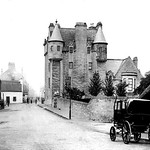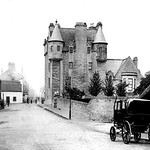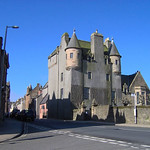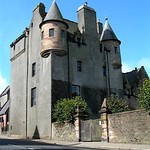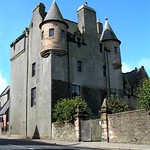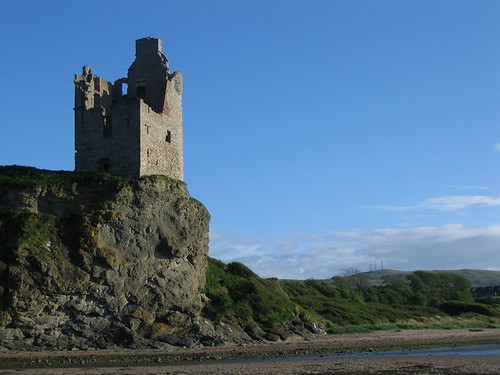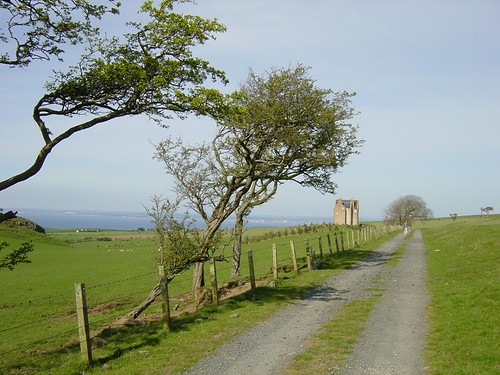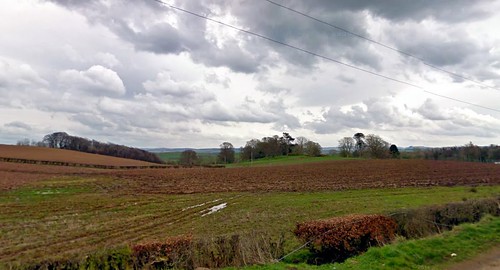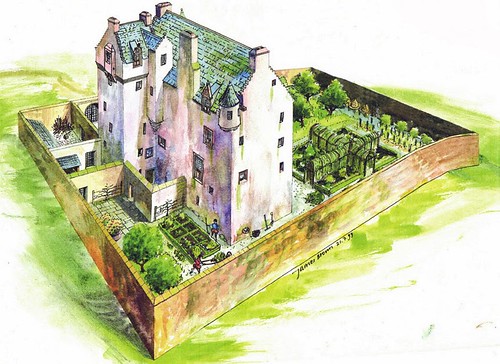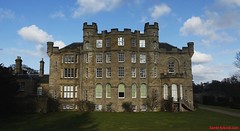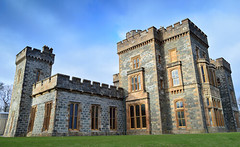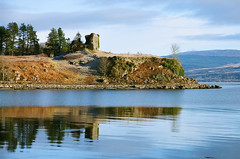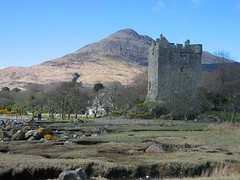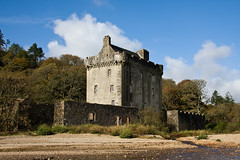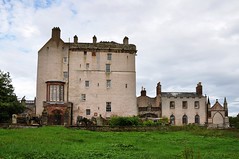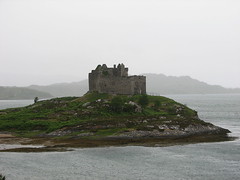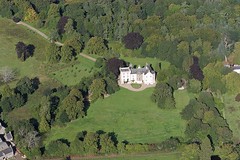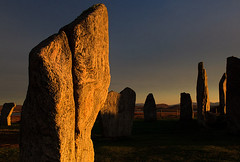Maybole Castle
Another of the Kennedy Carrick castles from this dominant Carrick family. Still used by the factor of the local Kennedy estates. Can be viewed externally from the street. Most interesting for the mythological history.
The Castle is the oldest inhabited house in the town having been built about the middle of the sixteenth century (no exact date can be given but it is believed to be around 1560). It was the town house of the Earls of Cassillis who spent most of the winter months in Maybole in those days and was the largest and finest of the twenty-eight lairds’ houses which were written about by Abercrummie in 1686.
It was built in the style of a typical Scottish castle, with square tower and round turrets, and strong enough to protect its occupants from unfriendly neighbours, of whom there were many at that time. Originally it stood across the bottom of the High Street with the gates to the courtyard facing up the street and with a great part of it on the site now occupied by the Post Office. The main door was originally at the side of the square tower which faced up the High Street.
The main hall was above vaulted cellars which still remain and above the hall were the sleeping apartments. The retainers’ quarters were on the other side of the gateway which gave entrance into the castle yard which was built round the well now, locally known as "The Pump". The buildings were L shaped with the base forming the part still in existence and the longer side built where the Post Office and Public Library now stand and the part now demolished housed the servants, grooms, smiths, and other persons necessary for the service of a nobleman in the sixteenth century. The tower is capped by a lovely little oriel window looking up the High Street (described by McGibbon and Ross in their books on Scottish Castles as "a rare specimen"), with heads carved round it which local people wrongly believe represent the heads of Johnnie Faa and his gypsies. The corbels to the roof of the little room at the top of the tower (known as the Countess’s Room) are carved with male and female heads and symbols of fertility.
A square recess about fifteen feet from the base of the tower originally held a stone carved with arms of the Cassillis family. The walls are extremely thick (in some places about seven feet) and it must have originally been a safe retreat in troublesome times when the Earls could live in it, with their own men around them in the small township clustered on the hillside below it. It was from Maybole Castle that the Earl of Cassillis and his men sallied forth to the fight at Ladycross in December, 1601, when young Bargany. was killed in the bitter feud between the Cassillis and Bargany families. Locally there is an old tale of the Countess of Cassillis being imprisoned in the "Countess’s Room" at the top of the tower, after she had allegedly eloped with Johnnie Faa, King of the Gypsies, but while the story is a delightful one, facts disprove it.
As years passed the Earls spent less and less of their time in Maybole, and gradually the old Castle fell into a state of disrepair and it became practically abandoned except for a few old retainers who lived in some of the outbuildings. In 1805 the Earl of Cassillis agreed with the town council that the part sited where the Post Office stands could be demolished to allow a road to be formed from the foot of the High Street to Duncanland Toll at the bottom of Redbrae. When the old buildings were removed the Earl decided to repair the old Castle and in 1812 reroofed it and built the additions which are now the Marquess of Ailsa’s Estate Offices and the living rooms above, also the Dining Room and new kitchen premises. The gardens and park bad walls erected round them and from 1812 the Castle has remained as it is now and it has been the home of Lord Ailsa’s Estate Factors from then until the present day.
In 1919 fire broke out in it and part of the roof was destroyed and had to be repaired. It has a commanding position at the bottom of the High Street and makes an attractive entry to the town from the Ayr Road and when the Library (1905), Post Office (1913) and the building at the head of the Kirkwynd (1894) were erected the builders harmonised the new buildings with the old Castle by making crow stepped gables, etc., and this little corner of Maybole has a dignity which can compare with any part of any town in Scotland.
In olden days another Castle stood at the top of the High Street, facing down the street to Maybole Castle, and the street was closed at both top and bottom of the hill by these two buildings which stood, like watch-dogs, over the Minniebolers as they thronged the booths set up in the High Street at the quarterly fairs or gathered to listen to proclamations from the drummer on the steps of the Town Cross. This building was originally the town house of the Lairds of Blairquhan and again was built in the usual style of Scottish castles with strong walls, a tower, and turrets. It is not known when it was originally built but it is believed to be older than the Castle. The building was quite large and occupied part of the site now occupied by Cameron’s Garage and the Royal Bank. About the end of the seventeenth century it was formed into the Court House and Tolbooth for the town, when a great part of the building was removed, and only the tower, part of the Lesser Town Hall, and a square building with a raked crow stepped gable were left.
There are many old prints showing this building in the early nineteenth century and they give a good picture of the Town’s jail and Council House and the Seal of the Burgh is a representation of the old Tolbooth. The prison cells were under the Court Room and they must have housed many prisoners in their time, as the Courts of Carrick met there and dealt out justice to all accused of every type of crime from poaching to murder. When the Court Room was not in use for the meetings of the Councillors it was let out as a "Dancing Room" and to actors to present their plays and many of the prisoners in the cells below must have had a few sleepless nights when the fiddlers played reels for the dancers above them. The old "jouggs" for the necks of prisoners used to hang above the door at the bottom of the tower and the "stocks" for their feet lay in a room at the top of the tower, but the "jouggs" went amissing about the end of the last century, and the "stocks", although still in existence in the 1930s, have also been lost.


